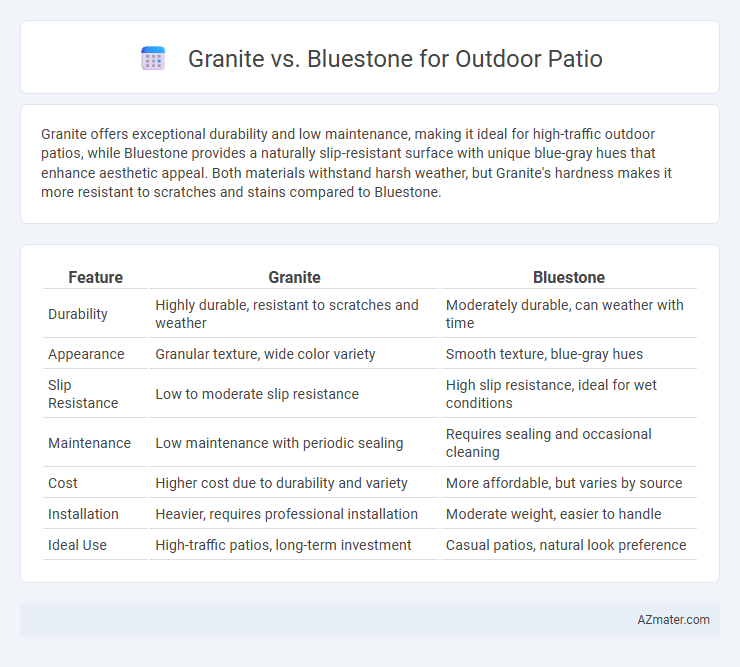Granite offers exceptional durability and low maintenance, making it ideal for high-traffic outdoor patios, while Bluestone provides a naturally slip-resistant surface with unique blue-gray hues that enhance aesthetic appeal. Both materials withstand harsh weather, but Granite's hardness makes it more resistant to scratches and stains compared to Bluestone.
Table of Comparison
| Feature | Granite | Bluestone |
|---|---|---|
| Durability | Highly durable, resistant to scratches and weather | Moderately durable, can weather with time |
| Appearance | Granular texture, wide color variety | Smooth texture, blue-gray hues |
| Slip Resistance | Low to moderate slip resistance | High slip resistance, ideal for wet conditions |
| Maintenance | Low maintenance with periodic sealing | Requires sealing and occasional cleaning |
| Cost | Higher cost due to durability and variety | More affordable, but varies by source |
| Installation | Heavier, requires professional installation | Moderate weight, easier to handle |
| Ideal Use | High-traffic patios, long-term investment | Casual patios, natural look preference |
Introduction to Granite and Bluestone Patios
Granite patios offer exceptional durability and a wide range of colors, making them ideal for high-traffic outdoor spaces. Bluestone patios provide a natural, elegant look with their smooth texture and distinctive blue-gray hues, enhancing garden aesthetics. Both materials resist weathering and require minimal maintenance, ensuring long-lasting outdoor appeal.
Material Composition and Appearance
Granite, composed primarily of quartz, feldspar, and mica, offers a dense and durable surface with a granular appearance featuring speckles in various colors, ideal for high-traffic outdoor patios. Bluestone, a natural sandstone consisting mainly of quartz, feldspar, and clay minerals, presents a smooth, fine-grained texture with earthy blue-gray hues that weather gracefully over time. Both materials provide unique aesthetic qualities and robust durability, but granite's hardness and varied color palette contrast with bluestone's uniform coloration and softer feel.
Durability and Weather Resistance
Granite offers exceptional durability and superior weather resistance, making it ideal for outdoor patios exposed to harsh climates, as it resists chipping, cracking, and fading over time. Bluestone is also durable but tends to be softer and more porous, which can lead to increased susceptibility to weather-related wear such as erosion and staining. Choosing granite ensures longer-lasting performance with minimal maintenance, while bluestone requires periodic sealing to maintain its appearance and structural integrity.
Slip-Resistance and Safety
Granite offers superior slip-resistance due to its coarse, grainy texture that enhances traction, making it a safer choice for outdoor patios, especially in wet conditions. Bluestone, while aesthetically pleasing with its smooth surface, tends to be more slippery when wet, requiring additional treatments or finishes to improve safety. Prioritizing slip-resistance in patio materials reduces accidents and ensures long-term durability in outdoor environments.
Cost Comparison: Granite vs Bluestone
Granite typically costs between $50 to $100 per square foot for outdoor patios, making it a higher-end option compared to bluestone, which ranges from $30 to $60 per square foot. Installation costs for granite are generally more expensive due to its density and weight, requiring specialized labor and equipment, while bluestone is easier to cut and install, reducing overall labor expenses. Despite granite's higher initial cost, its durability and low maintenance can offer better long-term value compared to bluestone.
Installation Process and Complexity
Granite installation for outdoor patios requires specialized tools and professional expertise due to its heavyweight and hardness, ensuring precise cutting and leveling. Bluestone, being softer and more porous, offers a more straightforward installation with easier cutting and less labor-intensive processes, making it a preferred choice for DIY enthusiasts. Both materials demand careful subbase preparation and proper drainage to prevent shifting and ensure long-term durability in outdoor settings.
Maintenance and Longevity
Granite offers exceptional durability and low maintenance, resisting stains, scratches, and weather elements, making it ideal for long-lasting outdoor patios. Bluestone requires regular sealing and cleaning to prevent surface wear and discoloration but provides a natural slip-resistant texture suitable for various climates. Both materials have excellent longevity when properly maintained, with granite typically outperforming bluestone in toughness and resistance to environmental damage.
Environmental Impact and Sustainability
Granite is a natural igneous rock known for its durability and low porosity, requiring minimal maintenance and reducing the need for chemical sealants, which lessens environmental contamination. Bluestone, a dense sandstone, is often sourced locally in specific regions such as the Northeastern United States, decreasing carbon emissions related to transportation and promoting regional sustainability. Both materials are recyclable and long-lasting, but bluestone's natural variety and local availability generally offer a smaller carbon footprint compared to granite, which can sometimes be imported internationally.
Design Flexibility and Aesthetic Options
Granite offers a wide range of color variations and patterns, making it ideal for customized outdoor patio designs with a polished or textured finish. Bluestone provides a naturally elegant, subtle blue-gray tone with a honed or rough surface, lending a timeless and rustic appearance to patios. Both materials deliver durable options, but granite's diverse aesthetic options give it greater design flexibility for contemporary or traditional settings.
Final Verdict: Choosing the Best Stone for Your Patio
Granite offers exceptional durability and resistance to weathering, making it ideal for high-traffic outdoor patios that require longevity. Bluestone provides a natural, textured appearance with excellent slip resistance, perfect for creating a rustic or traditional aesthetic. Selecting between granite and bluestone depends on prioritizing either enduring strength and low maintenance (granite) or unique visual appeal and safer footing (bluestone).

Infographic: Granite vs Bluestone for Outdoor Patio
 azmater.com
azmater.com